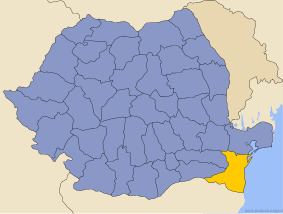Area rank 8th in Romania Area 7,071 km² | Time zone EET (UTC+2) | |
 | ||
Clubs and Teams FC Viitorul Constanța, HC Dobrogea Sud Constanţa, C.V.M. Tomis Constanța Points of interest Lake Siutghiol, MV E Evangelia, Aqua Magic, Complexul Muzeal de Științele, Delfinariu Constanta ‑ Complex Colleges and Universities Ovidius University, Mircea cel Bătrân Naval Ac, Andrei Şaguna University, Mihai Eminescu National | ||
Constanța ([konˈstant͡sa]) is a county (județ) of Romania on the border with Bulgaria, in the Dobruja region. Its capital city is also named Constanța.
Contents
- Map of ConstanC89Ba County Romania
- Demographics
- Geography
- Economy
- Tourism
- Politics
- Administrative divisions
- Historical county
- Administration
- After 1938
- References
Map of Constan%C8%9Ba County, Romania
Demographics
In 2011, it had a population of 684,082 and the population density was 96/km². The degree of urbanization is much higher (about 75%) than the Romanian average. In recent years the population trend is:
The majority of the population are Romanians. There are important communities of Turks and Tatars, remnants of the time of Ottoman rule. Currently the region is the centre of the Muslim minority in Romania. A great number of Aromanians have migrated to Dobruja in the last century, and they consider themselves a cultural minority rather than an ethnic minority. There are also Romani.
Geography
Economy
The predominant industries in the county are:
Agriculture is an important part in the county's economy, with Constanța being the county with the largest irrigation systems in the country (more than 4,300 km² before 1989, now greatly reduced), cereals being the most important products. Also, the county is famous for its wines from the Murfatlar region.
At Cernavodă there is a nuclear power plant with two reactors, each of the CANDU type of Canadian design. The plant covers over 15% of the country's power demand.
The Port of Constanța is the largest port in Romania and one of the most important on the Black Sea. It is linked with the Danube by the Danube-Black Sea Canal – the widest and deepest navigable channel in Europe, although it is not used to its full potential.
Tourism
The Romanian Riviera along the coast of the Black Sea is the preferred destination for the summer holidays in Romania. The resorts are, from North to South:
Also worth visiting are:
Politics
The current president of Constanța County Council is Horia Țuțuianu (Social Democratic Party).
The Constanța County Council, elected at the 2016 local government elections, is made up of 37 counselors, with the following party composition:
Administrative divisions
Constanța County has 3 municipalities, 9 towns and 58 communes:
Historical county
Following the 1926 administrative reform, the borders of the historical county are identical to the ones of the current Constanța County, with the exception of the Ostrov and Lipnița communes, which were then administered by the Durostor County, the Baia commune, now part of Tulcea County, and the villages of Tereskondu, Pârâul Caprei, Fundeni, Pădureni, Saldu Alde and Enigea-Haidar, now in Bulgaria.
Geography
The county neighboured the Black Sea to the east, the counties of Tulcea and Brăila to the north, Ialomița to the west, Durostor to the south-west and Caliacra to the south.
Administration
The county consisted of seven districts (plăși):
After 1938
After the 1938 Administrative and Constitutional Reform, this county merged with the counties of Ialomița, Durostor and Caliacra to form Ținutul Mării. It was re-established in 1940 after the fall of Carol II's regime. Ten years later, it was abolished by the Communist regime.
